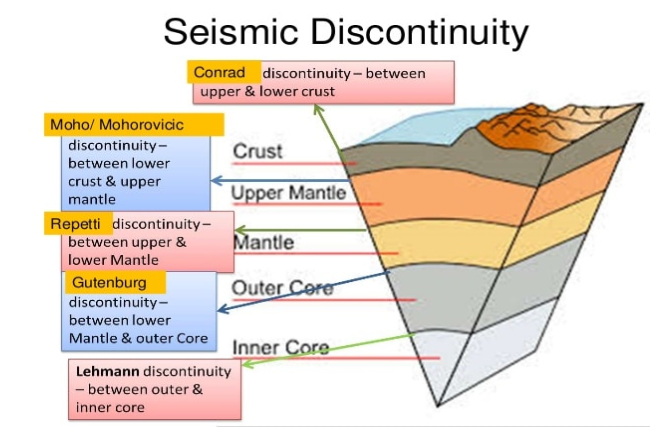STRUCTURE OF EARTH
The Earth's surface is constantly transformed by two types of forces: endogenic forces, which are internal, and exogenic forces, which are external. These changes brought about by these forces are collectively referred to as "geomorphic processes."
Diastrophism is the specific process responsible for reshaping the Earth's surface through the movement and displacement of rocks. It encompasses two main categories: orogenic processes, which lead to the formation of mountains, and epeirogenic processes, which are involved in the shaping of continents.
The Earth's interior can be divided into several layers: the crust, upper mantle, lower mantle, outer core, and inner core. As we move from the Earth's crust towards its core, the temperature steadily increases. Typically, the temperature rises by about 1 degree Celsius for every 32 metres toward the Earth's interior.

CRUST
- The Earth's crust is the outermost solid layer of the planet. It's divided into two main parts: the upper crust, often referred to as the continental crust, which is primarily composed of silica and aluminum (known as "sial"), and the lower crust, known as the oceanic crust, which is made up of silica and magnesium (termed "sima").
- The boundary that separates these two layers is called the "Conorod boundary."
- The thickness of the Earth's crust is not uniform and varies between continental and oceanic regions. Continental crust is generally thicker than oceanic crust.
- On average, the continental crust is about 32 kilometres thick, whereas the oceanic crust is much thinner, measuring approximately 5 kilometres in thickness. In areas with major mountain systems, such as the Himalayas, the continental crust can be exceptionally thick, reaching up to about 70 kilometres.
- The density of the Earth's crust is less than 2.7 grams per cubic centimetre (g/cm³).
MANTLE
- Beyond the Earth's crust lies a layer known as the mantle. The mantle is primarily composed of magnesium, silica, and iron and extends to a depth of approximately 2900 kilometres below the Earth's surface.
- The mantle itself is further divided into two main sections: the upper mantle and the lower mantle.
- The upper part of the mantle, referred to as the asthenosphere, extends to a depth of about 400 kilometres. The term "astheno" signifies weakness, and the asthenosphere is characterised by its partial melt and flow, which plays a crucial role as the primary source of magma that reaches the Earth's surface during volcanic eruptions.
- The boundary separating the lower crust from the upper mantle is known as the "Mohorovičić discontinuity" or simply the "Moho."
- The mantle has a density of approximately 3.9 grams per cubic centimetre (g/cm³).
- The combined layer consisting of the Earth's crust and the uppermost part of the mantle is referred to as the lithosphere. Its thickness can vary, ranging from 10 to 200 kilometres.
CORE
- Core- a region predominantly made up of heavy elements, particularly iron and nickel. This core is often referred to as the NiFe or Barysphere.
- It occupies the central portion of the Earth and has a remarkably high density, measuring about 13 grams per cubic centimeter (g/cm³).
- The core itself is divided into two main layers: the outer core, which is in a liquid state, and the inner core, which remains solid. The temperatures in this region are extremely high, ranging from approximately 5500°C to 6000°C.
- The Gutenberg margin delineates the separation between the lower mantle and the outer core.
- The Lehmann boundary marks the division between the outer core and the inner core.
- The core spans a considerable depth, extending from 2900 kilometres below the Earth's surface to the very centre of the planet at 6378 kilometres.

EARTH’S CHEMICAL COMPOSITION
The Earth's mass is estimated to be around 5.97 x 10^24 kilograms, which is equivalent to 5,970 yottagrams (Yg). This immense mass is composed of various elements, with the most abundant being:
- Iron (Fe): Approximately 32.1% of the Earth's composition.
- Oxygen (O): Approximately 30.1%.
- Silicon (Si): About 15.1%.
- Magnesium (Mg): About 13.9%.
- Sulphur (S): Approximately 2.9%.
- Nickel (Ni): About 1.8%.
- Calcium (Ca): Approximately 1.5%.
- Aluminium (Al): About 1.4%.
Additionally, there are trace amounts of other elements, making up the remaining 1.2% of the Earth's composition. This diverse combination of elements contributes to the Earth's unique characteristics and plays a crucial role in shaping its geology, chemistry, and overall properties.

